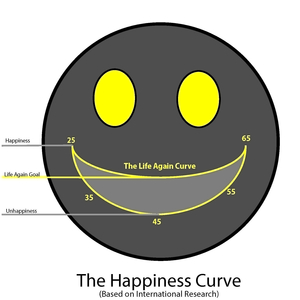GUEST BLOG- GARETH ANDREWS- THE HAPPINESS CURVE

One of the satisfying aspects of blogging on health and wellness is seeing and connecting with the wonderful work that others are doing in the blogosphere. Gareth Andrews, ex AFL Football player and businessman, started a Foundation called Life Again to inspire and connect men through time of change.
Times of transition are clearly very stressful for the individual, their partners and families. This article by Gareth is particularly insightful on happiness and the fluctuations and variations in happiness that occur during various stages of life. This understanding can help to accept that downtimes do occur and to take action to reduce the severity of these dips. Below is his blog published with Gareth’s permission. Great work Gareth!
Peter Pan Is A Myth
For a number of years now I have been using the smile on the human face to depict the U-shaped trend of happiness over our life span. It’s one of the images audiences really relate to. Effectively what it tells us is that we are happiest as teenagers and through our 20’s and early 30’s before we fall away into our early and mid 40’s to the unhappiest time of our lives. We eventually recover as we become happier again into our 60’s and beyond. This is not a local dilemma- similar results have been demonstrated by studies in both developing and developed countries throughout the world.
Why is it? Why is it that this thing we call Mid-Life Crisis really does exist? Why does it happen at an age when we should be feeling a level of contentment through family, through fulfilling relationships and through financial security? It doesn’t just happen to 99% of us! it also happens to the “best.” The so-called 1percenters. An article in the Harvard Business Review of 1999 showed that high flying Harvard graduates in their mid- 40’s were invariably sad, lonely, lost and unfulfilled and with the likelihood of another half of their lives to go. They were financially secure at an early age yet still stared into an abyss of malcontent.
As it turns out, part of the reason is said to relate to fundamental biology, perhaps to hormonal changes with growing old. It’s not just we humans- it seems that the great apes follow a U- shape pattern throughout life. In other words, there may be very little we can do about it other than grinning and bearing it. Grow older and recover your happiness!
But it’s not just hormonal. Marriage with its accompanying responsibility and domesticity, kids, financial pressures as we decide we need bigger and better houses, better holidays(“maybe Tuscany rather than Torquay this year darling.”), better schools, better clothes and better eateries. Our massive egos and the need to keep up with the Joneses drives us on and drives us to have it all. Men or women, it doesn’t seem to matter. We all suffer and we all pay a huge price through this suffering. Depression and suicide rates peak throughout this period and not everybody recovers their equilibrium enough to ever get back onto the happiness curve.
Interestingly enough I once saw an English study which suggested that men in particular have another flat spot in their mid 50’s when they begin to realise that many of their lifelong aspirations are no longer achievable. All of us who went about in our mid-20’s ready to take on and conquer the world start to face the fact that not only are we running out of time but also we don’t have the energy any more. And often in this rapidly changing world we don’t have the knowledge and skill sets of our kids and their cohorts- not to mention the invisibility that an aging body and face brings not only to the world at large but also to our own mirrors! How miserable.
Well guess what? A new Australian institute of Family Studies report was released last week which reported in The Daily Telegraph 17th September that “people are commonly unsatisfied with their life in their early 20’s to mid-30’s, with those feelings stabilising in our 40’s and dipping in our 50’s, before we experience our happiest times from our 60’s to 80’s.” The data had come from a 12 year study of almost 27000 Australians. In other words, although the shape of our curve has made a few twists and turns, nothing much has changed. Mid-life misery street is out there waiting for us.
Or is it? I don’t believe it should be taken for granted and I established Life Again 3 years ago for that very reason. I had been the perfect case study during my mid-life. The face could easily have been mine. Outwardly I was doing fine but inwardly I was churning. Had I known the role hormones play through our lives, I would have reasoned that they were the cause. “It’s what happens.” I wouldn’t have bothered digging any deeper and as it turned out I didn’t. I accepted my lot and put up my great barrier of defence. Which eventually came tumbling down.
What if we understand what is happening and do something about it? What if we accept that, like the great apes, the downward curve is unavoidable? It is part of life’s journey which takes us from babies to adulthood to old age. We aren’t all Peter Pan!
We have created the Life Again Curve. It graphs the benefits we can bring to our lives by recognising where we are going wrong. Our aim is to minimise the downward fall. Without proselytising too heavily, it begins with recognising the signs that our lives are changing and that we should start trying to minimise the risk of going too deeply down the unhappiness curve. Sounds simple. I can assure you it’s not. Like all the benefits we get from life, the results usually come from hard work- and surrounding yourself with good people. We must challenge ourselves and be prepared to change some of those things we know need changing.
I met a friend yesterday who discussed some of the so-called dramas he was experiencing in his life. Over a period of half an hour he detailed them. He understood them but didn’t want to own them. He asked me about a psychologist or psychiatrist who may be able to help. The interesting thing to me was he knew exactly what was wrong. He also actually had the tools to help himself. All he needed to do was practice some form of self-inquiry and establish what the blocks were to his happiness and well-being. He actually didn’t trust himself. Even having had the conversation we had helped him move in a positive direction.
Whether our “disease” is physical, mental,social,or all in combination, we all have the means to cultivate any or all of these elements in everyday life. Of course we have to be brave. If you actually hate your work environment or hate your choice of career, no monetary benefit should ever be taken into account in order to do something about it. Quitting smoking or quitting drinking need efforts of braveness as both are addictive. Yesterday I got a call for help from a friend. A key member of his staff had had a massive stroke and dropped dead. The same 41 year old had suffered a mild heart attack in January of this year and after 6 weeks leave, he came back to work and kept drinking and smoking after having being warned to quit both. Surely the warning from the first attack was enough. He didn’t take up life’s fight.
We all have to take up Life’s fight.Deep inside we know what to do. But we need each other’s help. It’s worth it.
Gareth


